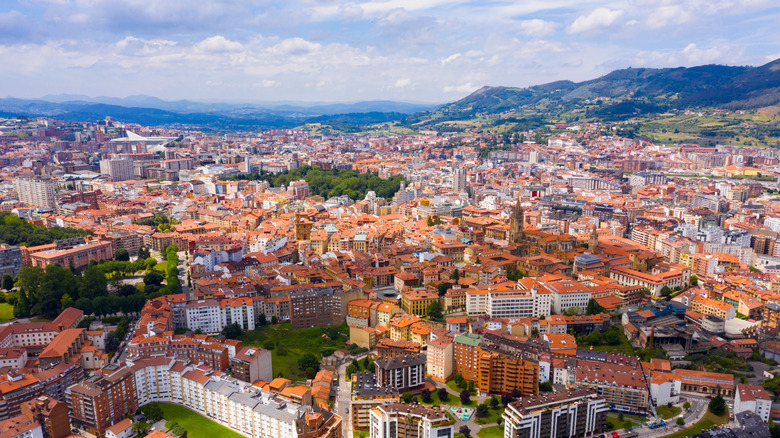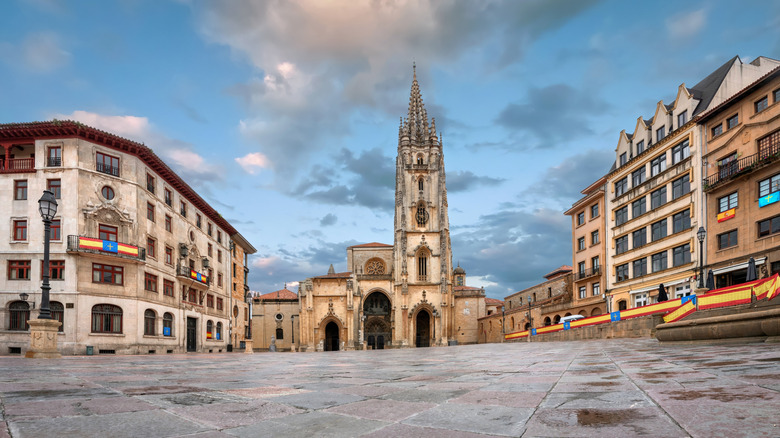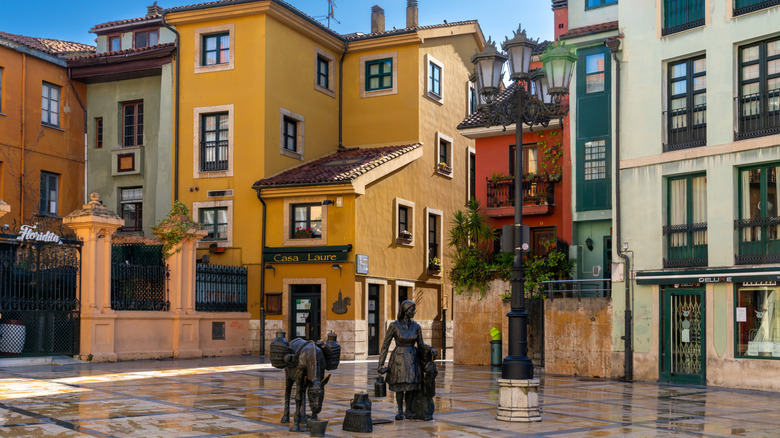This Less Touristy Barcelona Alternative Is A Hidden Gem Of Cider Bars, Scenic Hikes, And Quiet Charm
With glowing Mediterranean shores, a zesty food scene, and world-renowned architecture, Barcelona has yet to lose its sparkle, but unfortunately, it's become one of the most "overtouristed" places in Europe. More and more, travelers are looking for less crowded alternatives, and while many opt to visit other cities on the coast — Valencia and San Sebastian, for instance — those with the inside scoop know Spain's lush north makes for a much more peaceful and scenic holiday. A popular outpost among this is Oviedo, the capital of Asturias — a region nicknamed "Green Spain" for its verdant landscapes.
Its climate tempered by limestone mountains to the south and mild northern breezes off the Atlantic coast, Oviedo has stood through time. Originally built to be a monastic city dedicated to the Church of Saint Vincent, it was chosen to be the new capital of the Kingdom of Asturias in the 9th century, thanks to its strategic location nestled in the hills. But for a capital city, this one feels removed and quiet, perhaps closer to nature. With access to green spaces and surrounding national parks, plus Asturias' renowned foodie scene and a cider culture to rival the best Spanish wine, Oviedo should be a top choice for your next Spanish getaway.
What do see and do in Oviedo
While most of Spain runs with wine as its lifeblood, Oviedo prefers something more effervescent. Asturians have been pressing apples since at least the 1st century, using a natural fermentation process and a showy pouring ritual for best drinking that makes Asturian cider utterly unique. You can try sidrería-hopping on Calle Gascona to appreciate the breadth of flavors coming out of local orchards. Pair your sips with local cheeses aged in the surrounding mountains, like spicy blue Cabrales, clean-cut Vidiago, and smoky, crumbling Gamonedo.
Walk off all that indulgence with a tour of the Old Town, which retains a remarkably old-world feel thanks to the restriction against cars upon its cobbled streets. There, you'll witness beauties such as the Gothic cathedral on the edge of the main square and the Fine Arts Museum of Asturias, which is spread across three historic buildings, including a palace. A collection of medieval churches in and around the city makes up a UNESCO World Heritage Site worth viewing, and the central Campo de San Francisco park provides shady pathways among fountains and groves of trees.
Looking beyond the city, enjoy "Green Spain" up close. It takes about an hour to hike to the top of Monte Naranco, just outside Oviedo, and the walk there passes two of its UNESCO-protected churches (Santa María del Naranco and San Miguel de Lillo). You could cycle to the coast along the Senda del Oso trail, which runs along a historic rail route now overtaken by greenery. Parque Nacional de los Picos de Europa, a scenic gem that's Spain's oldest national park, is just over a two-hour drive east and is full of trails betwixt "picos" or peaks. You might even stumble across a working cheese-aging cave.
How to get there and where to stay
Oviedo is just 30 minutes from the Asturias Airport, but the surroundings are so pretty that a scenic bus or train ride may be a better way to get there. ALSA runs coach rides from Madrid frequently throughout the day, all around six hours long, with fares starting around $20 at the time of publication. A Renfe train ride is shorter at around 3.5 hours, for as little as $30.
While you'll find vacation rentals and guest houses throughout the city, boutique hotels remain a more common option. The NÚVO and Hotel Fruela offer modern elegance, while the Eurostars Hotel de la Reconquista provides a five-star stay within a nearly 300-year-old national monument, and the Hotel Palacio De La Viñona has regal rooms on its 18th-century estate outside the city. Consider booking your stay for mid-September when the Festival of San Mateo brings live performances, parades, and fireworks to the city.


